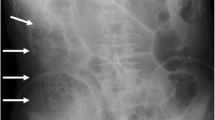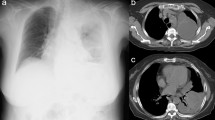Abstract
We report a case of a patient treated by retroperitoneoscopic partial nephrectomy who developed nitrogenous subcutaneous emphysema (SCE) as a complication. The use of a nitrogen gas-pressured fibrin tissue adhesive applied as a spray caused excessively increased pressure in the closed retroperitoneal space and resulted in widespread SCE with protracted clinical course. To the best of our knowledge, this is the first report of nitrogenous SCE associated with pneumoperitoneum. The clinical significance of nitrogenous SCE is emphasized, and the risks associated with the use of fibrin glue as a spray during laparoscopic surgery are discussed.



Similar content being viewed by others
References
Murdock CM, Wolff AJ, Geem TV. Risk factors for hypercarbia, subcutaneous emphysema, pneumothorax, and pneumomediastinum during laparoscopy. Obstet Gynecol. 2000;95:704–9.
Ng CS, Gill IS, Sung GT, Whalley DG, Graham R, Schweizer D. Retroperitoneoscopic surgery is not associated with increased carbon dioxide absorption. J Urol. 1999;162:1268–72.
Hirsch IH, Moreno JG, Lotfi MA, Gomella LG. Controlled balloon dilatation of the extraperitoneal space for laparoscopic urologic surgery. J Laparoendosc Surg. 1994;4:247–51.
Ludwig KA. Implications of subcutaneous emphysema and how to avoid and/or limit its development. In: Whelan RL, Fleshman JW, Fowler DL, editors. The Sages manual. New York: Springer; 2006. p. 273–80.
Shekarriz B, Stoller ML. The use of fibrin sealant in urology. J Urol. 2002;167:1218–25.
Kram HB, Shoemaker WC, Clark SR, Macabee JR, Yamaguchi MA. Spraying of aerosolized fibrin glue in the treatment of nonsuturable hemorrhage. Am Surg. 1991;57:381–4.
Druckrey-Fiskaaen KT, Janssen MW, Omidi L, Polze N, Kaisers U, Nur I, Goldberg E, Bokel G, Hauss J, Schön MR. Laparoscopic spray application of fibrin sealant effects on heamodynamics and spray efficiency at various application pressures and distances. Surg Endosc. 2007;21:1750–9.
Umegaki T, Nishi K, Murao K, Takahira K, Shingu K. Lethal air embolism after spray of tissue adhesive-fibrinogen and factor XIII aerosol during laparoscopic partial nephrectomy (in Japanese with English adstract). Masui (Jpn J Anesthesiol). 2007;56:1203–5.
Thompson DF, Letassy NA, Thompson GD. Fibrin glue: a review of its preparation, efficacy, and adverse effects as a topical hemostat. Drug Intell Clin Pharm. 1988;22:946–52.
Atrah HI. Fibrin glue. Br Med J. 1994;308:933–4.
Olsen PS, Hjelms E. Intravascular air after fibrin sealing by spray gun in cardiovascular surgery. Eur J Cardiothorac Surg. 1989;3:376–7.
Imai H, Nakatani N, Matsuda S, Murakawa K, Tashiro C. Sudden difficulty in ventilation due to massive subcutaneous emphysema during laparoscopic cholecystectomy (in Japanese with English abstract). Masui (Jpn J Anesthesiol). 2005;54:658–61.
Lehmann LJ, Lewis MC, Goldman H, Marshall JR. Cardiopulmonary complications during laparoscopy: two case reports. South Med J. 1995;88:1072–5.
Yagihashi Y, Okinami T, Fukuzawa S. Case of pharyngeal emphysema with airway obstruction during retroperitoneal laparoscopic nephroureterectomy (in Japanese with English abstract). Nippon Hinyokika Gakkai Zasshi (Jpn J Urol). 2009;100:540–4.
Schmidt SC, Langrehr JM. Re: Spray application of fibrin glue as risk factor for subcutaneous emphysema in laparoscopic transabdominal inguinal hernia repair. Surg Laparosc Endosc Percutan Tech. 2007;17:221–2.
Sciortino CM, Mundinger GS, Kuwayama DP, Yang SC, Sussman MS. Case report: treatment of severe subcutaneous emphysema with a negative pressure wound therapy dressing. Eplasty. 2009;9:e1.
Beck PL, Heitman SJ, Mody CH. Simple construction of a subcutaneous catheter for treatment of severe subcutaneous emphysema. Chest. 2002;121:647–9.
Bonjer HJ, Hazebroek EJ, Kazemier G, Giuffrida MC, Meijer WS, Lance JF. Open versus closed establishment of pneumoperitoneum in laparoscopic surgery. Br J Surg. 1997;84:599–602.
Cottin V, Delafosse B, Viale JP. Gas embolism during laparoscopy: a report of seven cases in patients with previous abdominal surgical history. Surg Endosc. 1996;10:166–9.
Priestley JG, Schwarz H. The solubility of acetylene in blood. I. Determination of acetylene dissolved in blood or other liquids. J Physiol. 1940;99:49–56.
Schulze T, Kumpf O, Rau B. Massive subcutaneous emphysema after thoracoscopic argon beamer use for pleurodesis. Surg Laparosc Endosc Percutan Tech. 2005;15:252–5.
Magrina JF. Complications of laparoscopic surgery. Clin Obstet Gynecol. 2002;45:469–80.
Author information
Authors and Affiliations
Corresponding author
About this article
Cite this article
Matsuse, S., Maruyama, A. & Hara, Y. Nitrogenous subcutaneous emphysema caused by spray application of fibrin glue during retroperitoneal laparoscopic surgery. J Anesth 25, 426–430 (2011). https://doi.org/10.1007/s00540-011-1120-9
Received:
Accepted:
Published:
Issue Date:
DOI: https://doi.org/10.1007/s00540-011-1120-9




